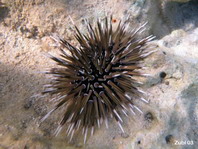

Nature abounds with examples of evolutionary arms races. Certain marine snails, for example, evolved thick shells and spines to avoid be eaten, but crabs and fish foiled the snails by developing shell-crushing claws and jaws.Common as such interactions may be, it's often difficult to trace their origins back in evolutionary time.Now, a study by University of Michigan paleontologist Tomasz Baumiller and colleagues finds that sea urchins have been preying on marine animals known as crinoids for more than 200 million years and suggests that such interactions drove one type of crinoid -- the sea lily -- to develop the ability to escape by creeping along the ocean floor. The work, which builds on previous research on present-day sea lilies and urchins, is scheduled to be published online in the Proceedings of the National Academy of Sciences.With their long stalks and feathery arms, sea lilies look a lot like their garden-variety namesakes. Perhaps because of that resemblance, scientists long had thought that sea lilies stayed rooted instead of moving around like their stalkless relatives, the feather stars. But in the 1980s, Baumiller and collaborator Charles Messing of Nova Southeastern University's Oceanographic Center in Dania Beach, Fla., observed sea lilies shedding the ends of their stalks to release themselves from their anchor points and using their feathery arms to crawl away, dragging their stalks behind them.Then, while going through hundreds of hours of video shot during submersible dives, the two researchers came across footage that offered an explanation for why sea lilies might get up and go. The videos showed sea urchins lurking in gardens of sea lilies, some of which appeared to be creeping away from the predators. In some photos, the sea floor around the urchins was littered with sea lily arms, like table scraps left from a feast. Further studies by Baumiller, Messing and Rich Mooi of the California Academy of Sciences suggested that sea urchins don't simply scavenge bits of dead sea lilies that they find on the ocean floor; they bite pieces right off their prey, giving sea lilies plenty of reason to shed their stalk ends like lizards' tails and scoot away.When those findings were announced in 2005, the researchers said the next step was to scrutinize fossil crinoids for clues to how and when sea lilies developed the ability to shed their stalk ends and move around. In the new research being reported in PNAS, that's what they, along with Forest Gahn of Brigham Young University and Polish collaborators Mariusz Salamon and Przemyslaw Gorzelak, have done.First, the researchers put sea urchins into a tank with detached crinoid arms, pieces of crinoid stalks and arms, and live crinoids. Every urchin that was given the opportunity at least nibbled on crinoids, and one even ate a whole feather star. This experiment not only confirmed that urchins prey on crinoids, but it also revealed that crinoid parts that pass undigested through urchins bear characteristic scratches and pits that match the size and shape of the teeth in the urchin's "mouth."To find out whether urchins preyed on crinoids in the distant past, the researchers looked for the same kinds of bite marks on more than 2,500 crinoid stalk fossils from Poland, dating back to the middle of the Triassic period, some 225 million years ago. More than 500 of the fossils had the telltale markings.The findings suggest that the development of motility in crinoids, as well as other escape strategies such as active swimming and floating, were stimulated by their interactions with predators. The time frame is significant, too, said Baumiller, professor of geological sciences and a curator at the U-M Museum of Paleontology. Some of the best examples of the effects of escalating interactions between predators and prey come from something called the Mesozoic Marine Revolution (MMR), a dramatic increase in the diversity of predators and their prey that started during the late Mesozoic Era, about 150 million years ago. But the new study suggests that, at least for crinoids and their predators, the arms race began even earlier.
No comments:
Post a Comment